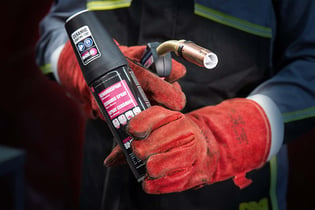In the world of metalworking, everyone is looking for a way to bring down the cost of their process. An inexpensive and relatively easy way to do so is with chemicals. Specifically, using anti-spatter chemicals for your welding consumables to prolong the life of your contact tips, nozzles, and diffusers.
Among the many anti-spatter solutions available, one that has increasingly become more popular in recent years is ceramic spray. You may have heard about it already, but is it worth it? Can it save you money? Is it even a good fit for you?
What is Ceramic Spray?
 Ceramic spray is a silicone free, protective coating containing ceramic (Boron Nitride) powder which is applied via aerosol spray.
Ceramic spray is a silicone free, protective coating containing ceramic (Boron Nitride) powder which is applied via aerosol spray.
Once applied and dried, this spray creates a barrier between your equipment/workpiece and spatter. This barrier prevents excessive spatter and contaminants from building up on the applied surfaces, meaning less time cleaning up work pieces and a longer life for your consumables.
Most ceramic sprays are not silicone based, which means it can be applied safely to surfaces that will be painted down the line. On top of that, the frequency of respraying your parts or equipment is much less than other anti-spatter methods because ceramic holds up much better to heat than water and oil-based anti-spatter solutions.
How Effective is Ceramic Spray?
The effectiveness of ceramic spray in your process depends on the base metals, wire types, gas types, and parameters used. This will vary greatly from process to process, so here are a few general tips:
Base Metals
Some base metals produce more spatter than others. For instance, galvanized base metals produce high amounts of spatter due to their zinc coating, making galvanized processes a perfect candidate for ceramic spray. On the other hand, in a MIG welding process, stainless steel and aluminum applications produce much less spatter. In these cases, ceramic spray will still help to prolong the life of your consumables and fixtures more so than reduce spatter build up.
Gas Types
There are many different gas types and mixtures, but typically, the amount of spatter directly correlates to the amount of CO2 within that mixture. The more CO2 you have, the more spatter you will get. This is especially true for processes that use carbon steel.
Introducing more carbon results in increased spatter. Including ceramic spray in high carbon applications can significantly reduce the amount of spatter, and make it easier to remove remaining spatter on your fixtures and consumables, increasing their lifespan.
Wire Types & Parameters
- Certain wire types such as solid core and flux core use more CO2 in their processes. This increases the amount of spatter. Metal core wire is a tubular type wire that has a combination of arc stabilizers, metal powder, and alloys within the wire. Metal core wire generally produce much less spatter due to their higher deposition rate efficiency, which lowers the number of consumables being wasted.
- Generally, the higher you set your parameters, the more spatter you will get. This is not always the case, but for high parameter applications (ex: long welds, thick plate) we recommend using ceramic spray to help combat the high heat and spatter.
In all cases, ceramic spray will help you reduce the amount of spatter sticking to your equipment and work pieces, prolonging the life of your equipment and consumables while decreasing downtime. How effective it will be for you, depends on the factors outlined above.
Where is Ceramic Spray used?
Ceramic spray is versatile. It can be used in many applications, even some you may not have considered:
Welding
In welding, ceramic spray is generally used to prevent excessive spatter build up on the welding torch, its consumables, and work pieces. Interestingly though, I have a customer who welds tubular dune buggy frames and they use ceramic spray on their fixtures to prevent the work piece from getting stuck and/or warping upon removal.
Cutting
Ceramic spray isn’t just for welding. It is commonly used in plasma cutting as well to prolong the life of the torch nozzles by deflecting heat and combating spatter or slag build up. Additionally, ceramic spray is frequently sprayed on the work pieces, especially in a stacking scenario, to prevent the falling slag from sticking to the pieces or fusing them together.
Where ceramic spray isn’t a good fit
Although uncommon, in some cases ceramic spray not be a good fit for your process.
Smaller, lower volume shops may not see a financial benefit of using ceramic spray. On the flip side, very large shops with high production volume may need to monitor/enforce the amount of ceramic spray being used per day (a good practice is to apply ceramic spray 2-3 times per day) or risk seeing a negative financial impact from applying ceramic spray more often than necessary. In these cases, making sure your parameters are exact for your specific process will help reduce spatter.
Additionally, if your facility is environmentally friendly or green, you will need to be mindful that the type of ceramic spray being used is certified eco-friendly.
Cost of Ownership
Cost is a big factor when switching to ceramic spray from other anti-spatter methods. Ceramic spray on average is 3-4 times more expensive than the alternative. Even still, ceramic spray can help save you money long term. No matter if spatter isn’t an issue for you, using ceramic spray will protect your consumables from contaminants and extend their life.
Inventory management is important to see a return on investment. I’ve visited customers who use ceramic spray too often, thus forcing them to buy more. Always use the spray at the recommended amount, by the manufacturer, to ensure proper life of each can of spray. You can also use a cone, provided by multiple brands, that dispenses the correct amount of spray directly onto your torch consumables. This will make sure that you aren’t wasting any due to overspray.
As stated above, you may have a hard time justifying the cost if your process is smaller with less personnel/equipment and would be better off using nozzle dip or water-based anti-spatters.
Conclusion
Anti-spatter ceramic spray is a small, amazing tool that can make a big impact on your efficiency in production, as well as extending the life of your equipment. Everyone and every process can benefit from the use of ceramic spray, but it all comes down to cost and implementation.
Ask yourself these questions:
- What is my process?
- What materials are used?
- How many pieces of equipment could I use ceramic spray with?
- Does my process suffer from spatter related downtime or material costs?
Hopefully after answering those questions it will be clear if ceramic spray is a good solution for your welding operation.

